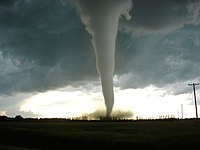
Photo from wikipedia
National Aeronautics and Space Administration's Cyclone Global Navigation Satellite System (CYGNSS) mission has gained significant attention within the land remote sensing community for estimating soil moisture (SM) by using the… Click to show full abstract
National Aeronautics and Space Administration's Cyclone Global Navigation Satellite System (CYGNSS) mission has gained significant attention within the land remote sensing community for estimating soil moisture (SM) by using the Global Navigation System Reflectometry (GNSS-R) technique. CYGNSS constellation generates Delay-Doppler Maps (DDMs), containing important Earth surface information from GNSS reflection measurements. Previous studies considered only designed features from CYGNSS DDM, whereas the whole DDM image is affected by SM, inundation, and vegetation. This paper presents a deep learning (DL) based framework for estimating SM in the Continental United States by leveraging spaceborne GNSS-R DDM observations provided by the CYGNSS constellation along with remotely sensed geophysical data. A data-driven approach utilizing convolutional neural networks (CNNs) is developed to determine complex relationships between the reflected measurements and surface parameters which can provide improved SM estimation. The model is trained jointly with three types of processed DDM images of analog power, effective scattering area, and bistatic radar cross-section with other auxiliary geophysical information such as elevation, soil properties, and vegetation water content (VWC). The model is trained and evaluated using the Soil Moisture Active Passive (SMAP) mission's enhanced SM products at a 9 km resolution with VWC less than 5 kg/m2. The mean unbiased root-mean-square difference between concurrent CYGNSS and SMAP SM retrievals from 2017 to 2020 is 0.0366 m3/m3 with a correlation coefficient of 0.93 over fivefold cross-validation and 0.0333 m3/m3 with a correlation coefficient of 0.94 over year-based cross-validation at spatial resolution of 9 km and temporal resolution similar to CYGNSS mission.
Journal Title: IEEE Journal of Selected Topics in Applied Earth Observations and Remote Sensing
Year Published: 2022
Link to full text (if available)
Share on Social Media: Sign Up to like & get
recommendations!